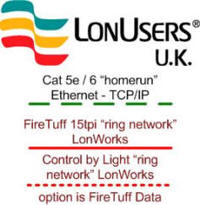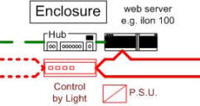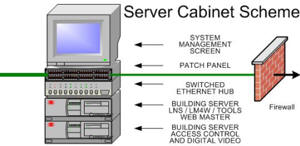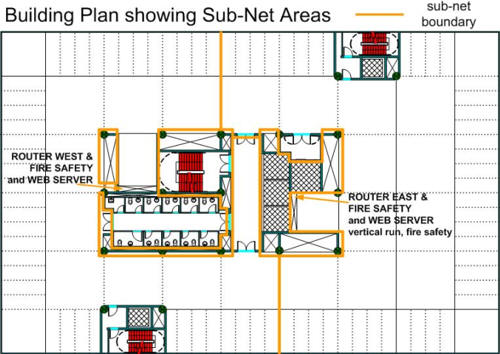July 2004
![]()
AutomatedBuildings.com
[an error occurred while processing this directive]
(Click Message to Learn More)
July 2004 |
[an error occurred while processing this directive] |
|
June's
article
More
Intelligent Building and save money, VBHQ part 2 |

Paul D.J. Mason, C.E.O. |
Interoperability

The flat open 2-tier system with web service and integrated sub-networks is the basis of the VBHQ. Please review the previous articles on the cost comparison model “Virtual Building Head Quarters”.

 LonMark certification seriously helps integration on the sub-networks of the
system that is the basis of the VBHQ. Sub-nets are the l ocal o
perating n etworks that connect to the backbone on the system.
Integration with LON is achieved best at the local sub-net through the direct
interoperation on those sub-networks and using the industry wide agreed
profiles. The industry wide spread is all the major companies please review the
LonMark sponsor list of companies who are actively involved in the product level
interoperation strategy. One should note the vertical separation of 3 tier
(including BACnet) doesn’t allow interoperability in the field between all the
products. LonMark certification allows interoperability in the field between all
the products and therefore the cost savings.
LonMark certification seriously helps integration on the sub-networks of the
system that is the basis of the VBHQ. Sub-nets are the l ocal o
perating n etworks that connect to the backbone on the system.
Integration with LON is achieved best at the local sub-net through the direct
interoperation on those sub-networks and using the industry wide agreed
profiles. The industry wide spread is all the major companies please review the
LonMark sponsor list of companies who are actively involved in the product level
interoperation strategy. One should note the vertical separation of 3 tier
(including BACnet) doesn’t allow interoperability in the field between all the
products. LonMark certification allows interoperability in the field between all
the products and therefore the cost savings.
The LonMark interoperability profiles are openly available at LonMark. LonMark International concerns itself with the profiles, the System and all the way up to the management level through the agreed XML profiles on the CABA initiative to OASIS. LonMark International is explained in this article.
The issue of integration such as that recommended in the VBHQ is not the technology. The technology works; rather it is the procurement of m&e elements across the divisions of traditional construction. Procurement advice will be dealt with in article 6, September 2004.
 “Lower cost ?” from the attached diagram “centralised – 3 tier – 2 tier” the
lower cost of the 2 tier solution can be believed as true in comparison with the
centralised system (not favoured at all) and the 3 tier system (favoured by
BACnet). The cost model comprehensively dispels the myth that integrated
intelligent buildings cost more; they cost less as soon as they are bought and
built correctly.
“Lower cost ?” from the attached diagram “centralised – 3 tier – 2 tier” the
lower cost of the 2 tier solution can be believed as true in comparison with the
centralised system (not favoured at all) and the 3 tier system (favoured by
BACnet). The cost model comprehensively dispels the myth that integrated
intelligent buildings cost more; they cost less as soon as they are bought and
built correctly.

The network topology of the VBHQ has been updated, (please take another look), and now uses Control by Light, as a BWP recommendation in large buildings or integrated fire detector buildings. This improvement is based on actual experience. Excerpts from the topology drawing are repeated here and give good advice on how it can be done. These schemes have already been designed by BWP and are built and the buildings occupied in London, UK. These buildings were for the government “immigration and nationality department” and the “department for constitutional affairs”. The IND used Control by Light extensively, the DCA scheme integrated HVAC, lights, disabled persons toilet alarm and the fire alarm system. The fire alarm sensors provided the temperature monitoring, PIR, sounder and fire detector as well as the emergency lighting system with white LED. Security was not integrated due to preference for the legacy system. The VBHQ includes fire detection and fire dampers to UK code and Loss Prevention requirements.

Other schemes are possible and depend on local support, preferences and scale considerations. In style terms BWP prefers to separate web service data from the engineering discipline, web service is dealt with through browsers for the majority of viewers of the data. Separate engineering assists the security integrity of the works.
LonMark System, Components of:
The LonMark System must be flexible enough to satisfy the needs of the specifier/consultant, integrator and end-user.
The system description has five categories:
[1] System Behaviours, [2] Devices, [3] Connectivity, [4] Device Interfaces, and
[5] Network Software & Tools.
The system behaviours set the tone and these are defined to be characteristics or benefits of the overall network/system that are afforded to the end-user or customer receiving such a LonMark System.
|
|
|
|
|
|
|
|
|
|
|
|
|
|
|
|
|
|
|
|
|
|
|
[an error occurred while processing this directive] |
Minimum system behaviours are proposed here to include the following:
The system will not be dependent upon connection to a centralised monitoring and control system for performance of control sequences; the system and its components shall to the greatest extent practical perform control sequences without reliance on the building-wide network or the monitoring-and-control system;
Installation of the hardware shall be such that individual control equipment can be replaced by similar control equipment from other equipment manufacturers with no loss of standardized system functionality;
All necessary documentation, configuration information, configuration tools, programs, drivers, and other software shall be licensed to, and otherwise remain with, the end-user; such that the end-user or their agents are able to perform repair, replacement, upgrades, and expansions of the system without subsequent or future dependence on the contractor;
Sufficient documentation and data including rights to documentation and data files shall be supplied to the end-user such that third-party contractors can bid on and perform the work to perform repair, replacement, upgrades, and expansions of the system without subsequent or future dependence on the contractor:
• A fully documented and published API for the network-management software must be made available to the end-user;
• At a minimum, three vendors shall have competing network tools available on the market that can interface directly with the network-management software;Hardware shall be installed and configured such that the end-user or their agents are able to perform repair, replacement, and upgrades of individual hardware without further interaction with the contractor;
An operator workstation (user interface) that provides for the same look and feel for monitoring and control regardless of which vendors system or subsystem an operator is viewing. As a result, system operators need only become proficient with one user interface;
An operator workstation (user interface) that provides for management of system operations through a single user interface; system operators and managers are afforded the means to efficiently and effectively manage operations;
Solutions approach to systems integration this includes the efficient interconnection of sub-systems;
A non-proprietary “point-database” that is openly accessible and that will support new monitoring and control applications.
For more information please contact LonMark about [2] Devices, [3] Connectivity, [4] Device Interfaces, and [5] Network Software & Tools in the LonMark System.
LonMark International
Introduction
LonMark International was announced on the 26th January 2004 at the ASHRAE show in Anaheim, USA. This company and 300+ association members takes over form the old “LonMark Interoperability Association” (LIA since 1994 and the original 36 members).
The purpose of LonMark International is to promote and advance the business of efficient and effective integration of open, multi-vendor control systems utilizing ANSI/EIA/CEA-709.1 (“open systems”) and related standards supported by AAR, CEN, IEEE, IFSF, and SEMI.

LonMark International is an independent not-for-profit trade association. It is funded by subscription and selling of some services; the association does rely on the voluntary work by the trade association members. This company, LonMark International (LMI), replaces the service (LIA) that was provided by the Echelon Corporation. The company “LMI” licenses a few things, logos etc from Echelon, has intellectual property considerations with respect to the “interoperable” profiles developed over the last 10 years by the members, operates open budgeting and has representation from the membership in a good quality governance model which includes 3 elected representatives from each of the three regions of the globe.
The governance model includes an executive board. The purpose of the executive board is to address day-to-day issues impacting the corporation. At the LMI Board of Directors meeting Tracy Markie of Engenuity Systems was elected as Chairman of the Board of Directors and Executive Board. George Huettel of Cyrus Technologies was elected as Vice Chairman of Board of Directors and of the Executive Board. Wayne Lambert of TAC AB was elected as a Director of the Executive Board. The staff working for LMI includes the Executive Director Barry Haaser and the engineers Jeremy and Ernst, please contact Derek Takegami for member services.
[an error occurred while processing this directive] The second key point to note is that in parallel with the corporate development is the LonMark System evolution, this specification moves the LonMark world on from “just” products to a holistic solution. This significantly helps the end-users, planners, specifiers, consultants. Ideally all a customer needs to do is ask for a “LonMark System”.
LonMark International look to provide significant value all the members. LMI will carry out shows and events internationally on a self-funding profitable basis for the benefit of the members of the Trade Association and education of the whole marketplace. Each of the local organisations will deal with their respective marketplaces although with appropriate and proportionate support from LMI. The engineering at LonMark continues to be very important and this is co-ordinated globally by LMI. In order to help to get to the target of a thousand LonMark certified products available to the marketplace LMI will provide a self-certification tool this year so all partner and sponsor members can release their products faster and at a lower development cost.
Members
It is the target that LonMark International has 1,000+ members. This is possible. Separate to the 300 person old LonMark Interoperability Association membership there are a number of LonUsers/LonMark around the world, includes organisations in Japan, Australia/NZ, Korea, Singapore and China, as well the LonUsers Europe.
In the last year the Chairmen of LonUsers Europe have moved together with the old LonMark Interoperability Association to create a “single market” with LonMark and in association with all worldwide groups, this is called LonMark International the new organisation launched at the ASHRAE show in Anaheim this year 2004. The prospective LonMark members from Europe are distributed as follows, 669 No. (June 2004); all groups are continuing to expand such that the 1,000 LonMark member target is quite possible! This is a major worldwide association, for example in comparison Profibus, the industrial control network bus, has 1,200 members currently.
|
Representive |
User Group |
|
|
Peter Albrecht |
LNO Austria |
25 |
|
Geert Janssens |
BeLON (Belgium) |
11 |
|
Edwin Sanggaard |
LonUsers Denmark |
85 |
|
Dr. Jürgen Hertel |
LNO (Germany) |
162 |
|
Veijo Piikkila |
LonUsers Finland |
16 |
|
Serge LE MEN |
LonUsers France |
36 |
|
Paolo Laganà |
LonUsers Italia |
31 |
|
Ferry Cserep |
LonUsers Netherlands |
32 |
|
Staale Killie |
LonUsers Norway |
8 |
|
Pawel Kwasnowski |
Polish LonUsers Group |
7 |
|
Aturo Garcia |
LonUser Spain |
9 |
|
Henrik Ebeklint |
LonUser Sweden |
142 |
|
Christoph Broennimann |
LonTech (Switzerland) |
47 |
|
Paul Mason |
LonUsers UK (ex-UKosa) |
48 |
Please note the twelve sponsor members (June 2004) of LonMark International are:
|
Circon Systems Corp |
Philips Lighting B.V. |
|
Echelon Corporation |
Samsung Electronics Co Ltd |
|
Fuji Electric Systems Co Ltd |
Siemens Building Technologies |
|
Honeywell International Inc |
TAC AB |
|
Johnson Controls Inc |
Trane |
|
NTT Data Corporation |
Yokogawa Electric Corporation |
At June 2004 each sponsor pays $20,000 fee direct to LonMark International, other members are partners ($5,000), associates ($1,000) and individuals ($100). Local fees are chargeable in the local organisations appropriate to those market places and those members dictates.
Next month
Come back for a commentary on Open Systems to help in all your respective
“arguments in this area”.
The programme we have for you continues to run as
follows :-
1. April "Intro"
2. May "VBHQ part 1",
or go to www.LonMark.org follow the VBHQ
motif
3. June "VBHQ part 2",
or go to www.LonMark.org follow the VBHQ
motif
4. July "LonMark International" and the "LonMark System"
5. August "Open Systems Standards”
6. September "Procurement Advice"
7. October "Everyone Wins"
8. November "Consultants Design Notes and Openness is Safer"
9. December "Case Study Notes for Consultants"
About the Author
Paul D.J. Mason B.Eng (Hons), C.E.O. at BWP plc who are based in London and the
East Anglia region United Kingdom. BWP have an affiliate office, DWP, in Paris,
France. BWP is a niche high quality building services consulting engineering
design service company and specialist in "green" engineering. BWP like
to think of themselves in their sector/region of the UK construction industry as
a BMW in a motor car metaphor comparison. BWP currently employ 47 people. Paul
(45) has a career encompassing Marine Engineering Royal Navy, the Property
Services Agency of the UK Department of Environment, University as a mature
student, and since 1989, with 2 private sector building services design
companies "CJP" and since 1997 "BWP". Since 1999 BWP
primarily specify LonMark and LonWorks Technology.
Paul is currently chairman of LonUsers United Kingdom and the task group leader Spring 2002 to Spring 2004 of the LonMark International "EuroTaG", the group with the duty to provide marketing planning advice in Europe to the LonMark International board. BWP are members of LonUsers UK, Associate members of LonMark International, the Intelligent Building Group, the British Council of Offices, Building Services Research and Information Association, Chartered Institute of Building Services Engineers and the Association of Consulting Engineers. Paul is an invited Contributing Editor through 2004 with www.automatedbuildings.com.
[an error occurred while processing this directive]
[Click Banner To Learn More]
[Home Page] [The Automator] [About] [Subscribe ] [Contact Us]